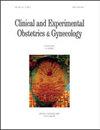在评估不孕症时宫腔镜能代替宫腔输卵管造影吗?宫腔镜显示输卵管转移的方法
IF 0.6
4区 医学
Q4 OBSTETRICS & GYNECOLOGY
引用次数: 1
摘要
背景:本研究的主要目的是证明宫腔镜在评估不孕症妇女的输卵管通道和子宫腔方面优于子宫输卵管造影。方法:研究对象为30名因不孕症需要对子宫腔和输卵管进行评估的女性志愿者。在宫腔镜输卵管通道评价中,从宫腔镜筒中取出一根6Fr进料套管,先将亚甲基蓝,再将气泡通过该柔性套管应用于充满液体的子宫腔。结果:参照方法为宫腔输卵管造影时,宫腔镜的特异性为85.71% (95% CI(置信区间):42.13% ~ 99.64%),敏感性为94.74% (95% CI: 85.38 ~ 98.90%)。宫腔镜阳性预测值为98.18% (95% CI: 89.78% ~ 99.70%),阴性预测值为66.67% (95% CI: 38.96% ~ 86.24%)。在评价管开度时,同时观察气泡和涡流效应可提高诊断的准确性。宫腔镜在评估输卵管通道方面的益处明显高于宫腔输卵管造影。结论:考虑到宫腔镜对子宫输卵管造影可能造成的细胞损伤,以及宫腔镜提供的真实观察能力,同时评估和使干预成为可能的舒适性,宫腔镜将是一种更有用和有用的应用。本文章由计算机程序翻译,如有差异,请以英文原文为准。
Can hysteroscopy be substituted to hysterosalpingography in the assessment of infertility? Methods of showing tubal transition as hysteroscopic
Background: The main goal of this study was to prove that hysteroscopy is a superior method compared to hysterosalpingography in the evaluation of tubal passage and the uterine cavity in infertile women. Methods: The study was carried out on 30 volunteer women for whom evaluation of the uterine cavity and transit through the tubules was required due to infertility. In the evaluation of the hysteroscopic tubal passage, a 6Fr feeding cannula was advanced from the hysteroscope barrel, and firstly methylene blue and then an air bubble were applied to the fluid-filled uterine cavity through this flexible cannula. Results: When the reference method was taken as hysterosalpingography, the specificity of hysteroscopy was found to be 85.71% (95% CI (confidence interval): 42.13%– 99.64%), sensitivity 94.74% (95% CI: 85.38–98.90%). The positive predictive value of hysteroscopy was calculated as 98.18% (95% CI: 89.78%–99.70%) and the negative predictive value was 66.67% (95% CI: 38.96%–86.24%). Observing the bubble and swirl effect together in the evaluation of the tube opening increases the diagnostic accuracy. And benefit of hysteroscopy in the evaluation of tubal passage was statistically significantly higher than hysterosalpingography. Conclusion: Considering the cellular damages that can be caused by hysterosalpingraphy and the real observation power provided by hysteroscopy, simultaneous evaluation and the comfort of making intervention possible, hysteroscopy will be a more useful and useful application.
求助全文
通过发布文献求助,成功后即可免费获取论文全文。
去求助
来源期刊
CiteScore
0.50
自引率
0.00%
发文量
241
审稿时长
1 months
期刊介绍:
CEOG is an international, peer-reviewed, open access journal. CEOG covers all aspects of Obstetrics and Gynecology, including obstetrics, prenatal diagnosis, maternal-fetal medicine, perinatology, general gynecology, gynecologic oncology, uro-gynecology, reproductive medicine, infertility, reproductive endocrinology, sexual medicine. All submissions of cutting-edge advances of medical research in the area of women''s health worldwide are encouraged.

 求助内容:
求助内容: 应助结果提醒方式:
应助结果提醒方式:


